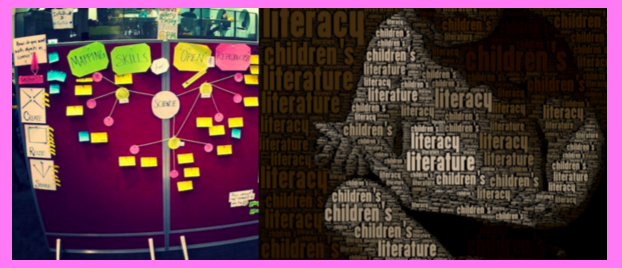


- What does it mean to be content literate? Everyone is content illiterate in at least one discipline. To be content literate, one must know:
- key vocabulary
- key conceptual frameworks that relate key vocabulary
- how to read and write within discipline
- understanding what big ideas are and how they are organized
- Literacy in the Curriculum: Various academic literacies exist because different disciplines process and package information in different ways. Becoming more aware of discipline-specific thinking is a first step to modeling this thinking for students. Thinking about subject specific literacy entails investigating:
- what types of reasoning/thinking are important?
- what genres of text are used?
- how to present and support arguments?
- what is the key vocabulary?
- Spoken and Written Language: Written language tends to be more explicit than spoken language because the context embedded around spoken language eliminates the need to say specifics. Explicit language can be used to bridge the gap between everyday language and the more formal language (that tends to be written language).
- Two Features of Academic Language:
- Nominalization: Changing verbs to their associated nouns (example: analyze -> analysis). Nominalization allows writer to talk about abstract ideas more concisely. To scaffold normalized words, use concrete examples and easy to understand words to define and illustrate the terms.
- Norminal groups: A group of nouns that contain a high density of information. The combination of nominalizations in nominal groups can lead to very dense texts. These are used to make writing more concise and allow for discussion of more general ideas. To build towards an understanding of texts with nominal groups and nominalizations, use everyday language and concrete examples.

It is humbling and perspective-building to be reminded that everyone is illiterate in at least one discipline’s genre(s). In addition to vocabulary, it is helpful to know that nominal groups and nominalizations can also make text harder to decode. Content-specific literacy is a set of skills that can not be presumed; they CAN and must be scaffolded. These skills include reading, writing, expressing, relating, and applying key ideas.

Preparation Steps
- Analyze texts related to targeted content and be aware of nominalizations and nominal groups
- Research scaffolding strategies that teach students how to read, write, inquire, apply and relate key ideas
- Research strategies for decoding texts of high lexile
- Research specific types of thinking that are needed to apply key ideas effectively
Early Implementation Steps
- Implement scaffolding activities that teach language, thinking, and content simultaneously. See Literacy articles for ideas.
- Prior to assigning dense texts, explicitly teach vocabulary in the text (both content and none-content related) that make text difficult to read
- Use concrete examples and everyday language to decode nominal groups and nominalizations for students
Advanced Implementation Steps
- Use models and conversations about models to scaffold development of writing skills within content specific genres
- Teach and frequently implement routines and strategies for digesting and annotating texts
- Students reflect on strategies and whether or not they are helping them better read and write within content

- See Literacy articles.
- See Rigor articles.
- See Differentiation articles.
